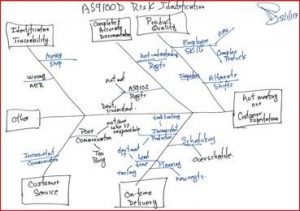By Paul Harbath, Quality Management Consultant
In a AS9100D “Risk Based Thinking” is considered a basic principle of an effective quality system. The concept of “preventive action” has been eliminated in AS9100D and replaced with “Risk Based Thinking”.

To meet this requirement your quality system must have evidence that the following happens regularly:
- Identify potential risks in your quality management system
- Analyze and evaluate the risks
- Mitigate, control and monitor unacceptable risk
First let’s talk about ways to identify potential risks. Standard SWOT analysis, cause and effect diagram, affinity diagram or other brainstorming processes are all effective methods to identify potential risks. The key to identification is to consider your customers’ expectations and the potential risk of not meeting these requirements.
Let’s use a cause and effect diagram as an example. In the box on the right of the cause and effect diagram the effect is written. In our case the effect would be: “Not meeting our customer expectations”. Here’s an example of what the diagram might look like.

Remember that risk identification should include the key people in the organization. The leadership and possibly some of the key shop members should be part of the brainstorming. Also be sure that this evaluation is “retained as documented evidence” of your quality system. In most cases I would recommend that you make it part of your regular AS9100D management review.
There are many great references on risk management. One of my favorites is the “Risk Management – Memory Jogger”. These references can help you create a formal method for meeting the “Risk Based Thinking” requirements of AS9100D.
 Paul Harbath is an industry expert with over 30 years of hands on experience in helping small manufacturers understand/implement quality management systems and lean/6-Sigma. Paul has a demonstrated ability to connect with the value adding employees by simplifying complex technical issues. Connect with him on LinkedIn.
Paul Harbath is an industry expert with over 30 years of hands on experience in helping small manufacturers understand/implement quality management systems and lean/6-Sigma. Paul has a demonstrated ability to connect with the value adding employees by simplifying complex technical issues. Connect with him on LinkedIn.
